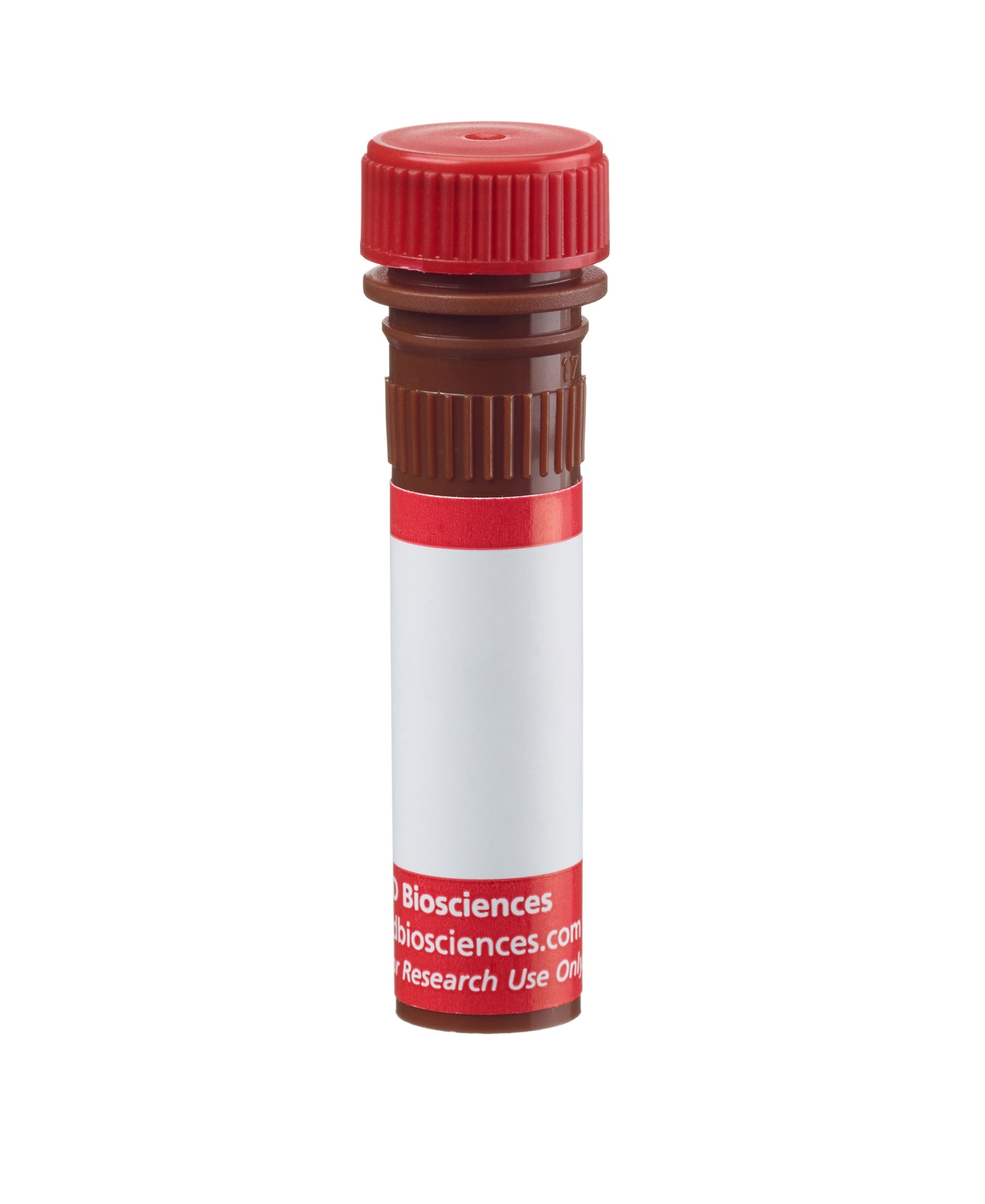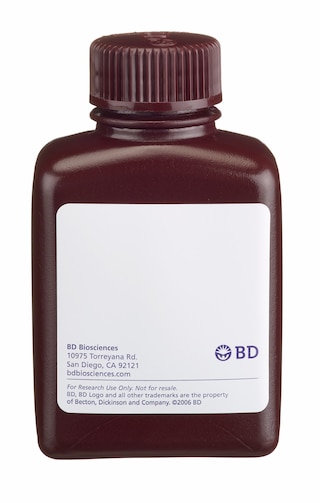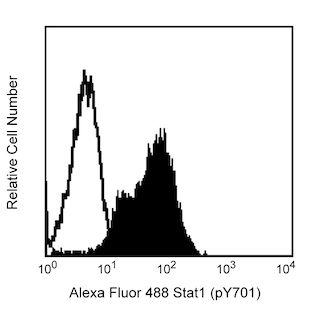Old Browser
This page has been recently translated and is available in French now.
Looks like you're visiting us from {countryName}.
Would you like to stay on the current country site or be switched to your country?




Immunofluorescent staining of human cell lines. HeLa cells (ATCC CCL-2) were cultured, fixed, permeabilized with cold methanol, stained with Alexa Fluor® 647 Mouse anti-Cytochrome c (pseudo-colored green), and counter-stained with Hoechst 33342 (pseudo-colored blue) according to the Recommended Assay Procedure. The images were captured on a BD Pathway™ 855 Bioimager System with a 20x objective and merged using BD Attovision™ software. This antibody also stains A549 (ATCC CCL-185) and U-2 OS (ATCC HTB-96) cells, and it works with either cold methanol or Triton X-100 permeabilization (see Recommended Assay Procedure).


BD Pharmingen™ Alexa Fluor® 647 Mouse anti-Cytochrome c

Regulatory Status Legend
Any use of products other than the permitted use without the express written authorization of Becton, Dickinson and Company is strictly prohibited.
Preparation And Storage
Recommended Assay Procedures
1. Seed the cells in appropriate culture medium at ~10,000 cells per well in a BD Falcon™ 96-well Imaging Plate (Cat. No. 353219), and culture overnight.
2. Remove the culture medium from the wells, and fix the cells by adding 100 µl of fresh 3.7% Formaldehyde in PBS or BD Cytofix™ fixation buffer (Cat. No. 554655) to each well and incubating for 10 minutes at room temperature (RT).
3. Remove the fixative from the wells, and permeabilize the cells using either cold methanol or Triton™ X-100:
a. Add 100 µl of -20°C 90% methanol or -20°C BD™ Phosflow Perm Buffer III (Cat. No. 558050) to each well and incubate for 5 minutes at RT.
OR
b. Add 100 µl of 0.1% Triton™ X-100 to each well and incubate for 5 minutes at RT.
Triton is a trademark of The Dow Chemical Company.
4. Remove the permeabilizer, and wash the wells twice with 100 μl of 1× PBS.
5. Remove the PBS, and block the cells by adding 100 µl of blocking buffer (3% FBS in 1× PBS) or BD Pharmingen™ Stain Buffer (FBS) (Cat. No. 554656) to each well and incubating for 30 minutes at RT.
6. Remove the blocking buffer, dilute the antibody conjugate 1:10 in blocking buffer or Stain Buffer (FBS), and stain the cells by adding 50 µl of the diluted antibody conjugate to each well and incubating for 1 hour at RT.
7. Remove the diluted antibody conjugate, and wash the wells three times with 100 μl of 1× PBS.
8. Remove the PBS, and counter-stain the nuclei by adding 100 μl of a 2 μg/ml solution of Hoechst 33342 (eg, Sigma-Aldrich Cat. No. B2261) in 1× PBS to each well at least 15 minutes before imaging.
9. View and analyze the cells on an appropriate imaging instrument. Recommended filters for the BD Pathway™ instruments are:
Instrument Excitation Emission Dichroic
BD Pathway 855 620/60 700/75 660 LP
BD Pathway 435 628/40 690/40 FF660
Product Notices
- Please refer to www.bdbiosciences.com/us/s/resources for technical protocols.
- This reagent has been pre-diluted for use at the recommended Volume per Test when following the Recommended Assay Procedure. A Test is typically ~10,000 cells cultured in a well of a 96-well imaging plate.
- The Alexa Fluor®, Pacific Blue™, and Cascade Blue® dye antibody conjugates in this product are sold under license from Molecular Probes, Inc. for research use only, excluding use in combination with microarrays, or as analyte specific reagents. The Alexa Fluor® dyes (except for Alexa Fluor® 430), Pacific Blue™ dye, and Cascade Blue® dye are covered by pending and issued patents.
- Caution: Sodium azide yields highly toxic hydrazoic acid under acidic conditions. Dilute azide compounds in running water before discarding to avoid accumulation of potentially explosive deposits in plumbing.
- Source of all serum proteins is from USDA inspected abattoirs located in the United States.
- Alexa Fluor® is a registered trademark of Molecular Probes, Inc., Eugene, OR.
Companion Products



A cytochrome is an electron-transporting protein that contains a heme prosthetic group. Cytochromes have been known to be essential components of the mitochondrial respiratory chain since 1925. The iron atom of the heme group in cytochromes alternates between a reduced ferrous (+2) state and an oxidized ferric (+3) state during electron transport in oxidative phosphorylation. Cytochromes are classified into four groups (a, b, c and d) according to spectrochemical characteristics, and there are five cytochromes between coenzyme QH2 and O2 in the electron transport chain. Cytochrome c is a water-soluble protein that either promotes cell survival or death, depending upon its intracellular location. In healthy cells, it is a peripheral membrane protein of the mitochondria that transports electrons from the coenzyme QH2 cytochrome c reductase complex to the cytochrome c oxidase complex. When proapoptotic stimuli induce breakdown of the mitochondria, cytochrome c is released to the cytosol where it functions in the activation of caspases that trigger apoptosis.
The 6H2.B4 monoclonal antibody has been reported to recognize the native and not the denatured form of rat, mouse, and human cytochrome c. Furthermore, studies utilizing competitive ELISA indicate that mAb 6H2.B4 binds to a region around residue 62 of rat cytochrome c.
Development References (6)
-
Arnoult D, Grodet A, Lee Y-J, Estaquier J, Blackstone C. Release of OPA1 during apoptosis participates in the rapid and complete release of cytochrome c and subsequent mitochondrial fragmentation. J Biol Chem. 2005; 280(42):35742-35750. (Clone-specific: Immunofluorescence).
-
Garrido C, Galluzzi L, Brunet M, Puig PE, Didelot C, Kroemer G. Mechanisms of cytochrome c release from mitochondria. Cell Death Differ. 2006; 13:1423-1433. (Biology).
-
Goshorn SC, Retzel E, Jemmerson R. Common structural features among monoclonal antibodies binding the same antigenic region of cytochrome c. J Biol Chem. 1991; 266(4):2134-2142. (Immunogen). View Reference
-
Jemmerson R, Johnson JG. different functional boundaries for the major antigenic region of two cytochromes c. Proc Natl Acad Sci U S A. 1991; 88:4428-4432. (Immunogen).
-
Liu X, Kim CN, Yang J, Jemmerson R, Wang X. Induction of apoptotic program in cell-free extracts: requirement for dATP and cytochrome c. Cell. 1996; 86(1):147-157. (Clone-specific). View Reference
-
Rossé T, Olivier R, Monney L, et al. Bcl-2 prolongs cell survival after Bax-induced release of cytochrome c. Nature. 1998; 391(6666):496-499. (Clone-specific: Immunofluorescence). View Reference
Please refer to Support Documents for Quality Certificates
Global - Refer to manufacturer's instructions for use and related User Manuals and Technical data sheets before using this products as described
Comparisons, where applicable, are made against older BD Technology, manual methods or are general performance claims. Comparisons are not made against non-BD technologies, unless otherwise noted.
For Research Use Only. Not for use in diagnostic or therapeutic procedures.
Report a Site Issue
This form is intended to help us improve our website experience. For other support, please visit our Contact Us page.